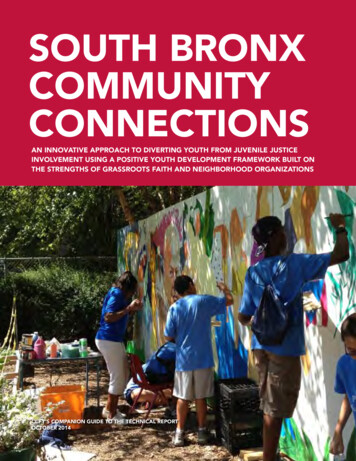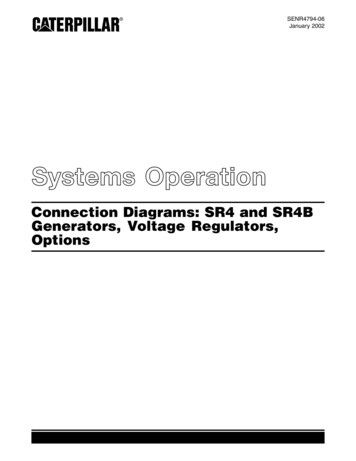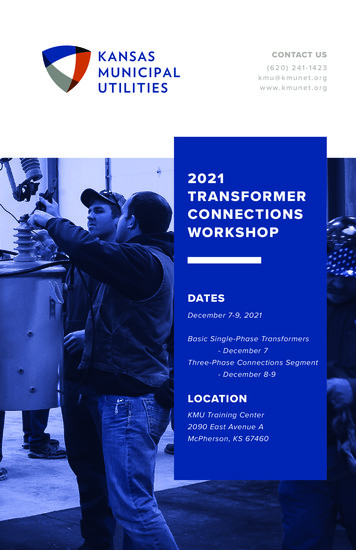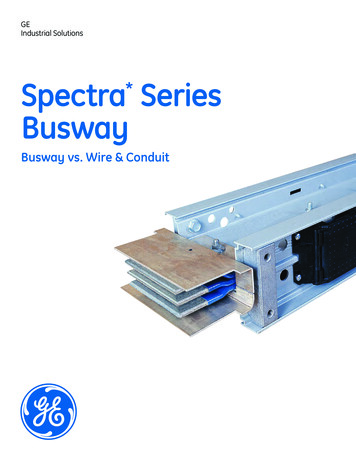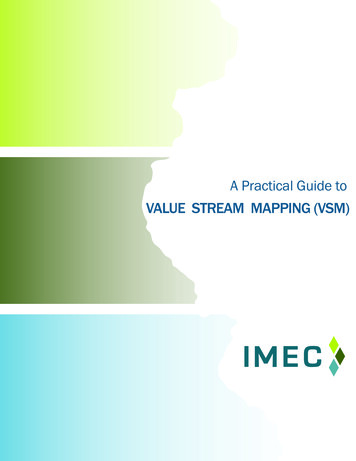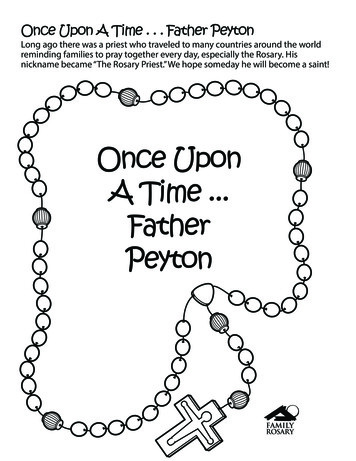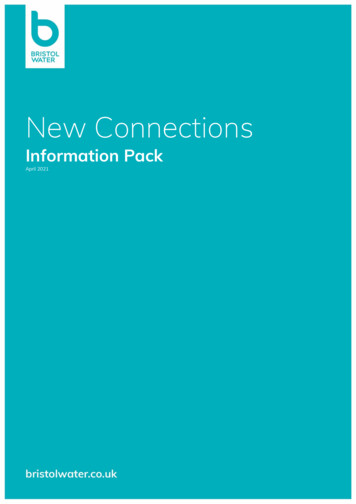
Transcription
New ConnectionsInformation PackApril 2021
Everything you need to know about installing a newwater supplyThis leaflet explains how to apply for a new water connection. It covers how tosubmit an application, the timescales involved and the things you will need todo before the connection can be madeYou will also find information on the replacement of lead and iron service pipesand shared service pipes. Reading the information in this document will help youensure that getting your new or replacement water supply flows as smoothly aspossibleIn some circumstance it is possible for those who require a new supply toarrange for someone other than Bristol Water to connect the service pipe; thisis known as self-lay. Information on the self-lay process is not included in thisleaflet, but if you require further information on this option, please read our SelfLay Policy – which is available on our website or via this opers/new-supplies-and-mains/self-layOur Supply Area
DefinitionsService Pipe – the complete length of the water pipe from the main (usually inthe street/footpath) to the first internal water fitting (usually an internal stoptap). The pipe is divided into two sections; the communication pipe and thecustomer supply pipeCommunication Pipe (CP) – normally the length of pipe from the connectionwith the water main, to a point where the pipe crosses the boundary of theproperty. This pipe is normally maintained by Bristol WaterSupply Pipe (SP) Customer Supply Pipe – the length of pipe from the boundaryof the property, up to the first internal water fitting. In exceptional cases thesupply pipe can extend right up to the connection to the main. This section isowned and maintained by the owner/s of the property/ies served by that pipeMains – most mains can be divided into one of two categories: distribution mainsand trunk mainsDistribution Mains – generally small diameter pipes that distribute water to anumber of buildings in an area. They are owned and maintained by BristolWater and are normally laid in the public highway – these can be in the road orfootpath. They can also be installed in privately owned streets or lanes andacross fields and public open spaces. Communication Pipes are connecteddirectly onto distribution mainsStrategic Mains – generally larger diameter mains that transfer water from onearea to another. We have no legal duty to make service connections to trunkmains ( as we cannot guarantee availability of water from these mains) and dueto their importance, we do not normally do so3
Boundary Box – the small underground chamber in which stop taps andmeters are installed. They are normally installed either in the footpath or lessthan one metre inside the boundary for the property supplied. They aremaintained by Bristol WaterWall Mounted Box – the same as a Boundary Box but are wall mounted on orwithin the wall of the property suppliedStop Tap/ Stop Cock – valves that stop the flow of water in a pipe and can beoperated by hand. Most buildings will have an internal Stop Tap, located on thesupply pipe as it enters the property ( often in the kitchen or hallway) and asecond external Stop Tap located in a Boundary Box. The internal Stop Tap isthe responsibility of the property owner, while the external Stop Tap is generallythe responsibility of Bristol Water, if it is located in the highway or within onemetre of the highway, except for stop taps within wall mounted boxes whichare also the responsibility of the property ownerTypical Supply Arrangement4
The Application ProcessApplication FormTo apply for a new supply, you should complete an Application For Supply Form(AFS) Form. You can complete this form online or download and print off a copy.If you do not have access to the internet, please contact us and we will send youa copy in the post. In all cases you will need to attach or enclose a site plan. Inaddition, if you are developing anything other than a greenfield site, you willneed to enclose a soil analysis report which should identify any potential groundcontamination risk. You will be able to attach all these documents to your onlineapplicationSite VisitOnce we receive your completed Application Form and site plan, we will contactyou to arrange a site visit so that our Network Site Agent (NSA) can visit you todiscuss the planned work. During this visit the NSA will establish the amount ofwork needed to make the new connections, explain what you will need to doand show you the point where the connection will be made and where you willneed to extend your supply pipesInspectionsYou are responsible for making sure your new supply pipe meets therequirements of the Water Supply (Water Fittings) Regulations 1999 as well asour connection requirements (these are detailed elsewhere in this leaflet) Youshould contact us once your site is ready for connection so that our NSA can visitand inspect the work. You may be charged for a re-inspection if your site is notready for connection when the NSA visits, or if the work does not meet all of therelevant connection requirements5
Quotation LetterFollowing the visit, we will send you a quotation letter detailing the chargesthat will be payable – these will normally include both a charge for installingthe new connection and an infrastructure charge. Any other charges will alsobe highlighted in the letter, for example the cost of applying to the localHighway Authority for the temporary closure of a road and the HighwayPermit Fee. You can find out more about charges on our website or in ourCharges Leaflet or via this on%20Services%2021-22.pdfYou will be sent a plan with your quotation letter; it will confirm where yoursupply pipe should terminate. Quotation Letters are normally sent out within28 calender days of receipt of your applicationUnless otherwise stated on the quotation letter, the quotation will expire on 31March of the financial year in which the quotation has issued. If your quotationhas expired and you still wish to proceed with the work, please contact us torequest an up to date quotation PaymentYou can make payment at any point during your work, but the connection cannotbe made until your work has passed an inspection, payment has been receivedand your work has passed all Water Supply ( Water Fittings) Regulations 1999The Infrastructure Charge becomes payable when the new connection has beenmade, however for ease of processing payments we encourage developers topay both the infrastructure charge and the connection charge at the same timebefore the connection is madeYou can pay us Online, in the New Supplies & Connections section of theBristol Water website or via this 16/index.php your Customer Number and AFSnumber will be on your quotation letter6
You can also pay by cheque or BACs (using Sort Code; 30-62-96 AccountNumber; 80966860) But whichever payment option you choose please ensureyou quote your Application Number on all payments. Once we have receivedyour payment, we will send you receipted invoicesConnectionWe aim to carry out most connections within 21 calender days from the dateyour connection passes its inspection, the date the payment is received, or thedate the work passes all Water Supply ( Water Fittings) Regulations 1999. Theonly exceptions to this are if your property is being connected to one of ourstrategic mains or if a road closure is required to complete the work. TrafficSensitive streets require a minimum 28 days notice to the Highway Authorityand a road closure requires a minimum of 12 weeks notice, This will be identifiedat quotation stageFrom the date of connection, you will be charged for water used as well as astanding charge.If the bill payer changes, please inform our BillingCompany: Pelican Business Services – www.pelican.co.uk or 0345 600 36007
Large DevelopmentsIf your development consists of six or more dwellings (or the rough equivalentin non-residential properties) you should, during the early planning of yourdevelopment, contact our Developer Interface Team with details of yourdevelopment to ensure that we will be able to supply your development. Youcan do this by completing the Basic Supply Strategy Application on ourwebsite via this link; gy-form or bydownloading and emailing the form to; developer.interface@bristolwater.co.ukFurther details of the information they require can be found in our DevelopersCharter, which can be found on our website or by clicking this r-April2020.pdfLarger developments often require new water mains to be laid. In addition, wealso need to make sure that our network will be able to accommodate the extrademand from the site. If your site does require new mains, you will need to applyfor them on a separate form, known as the Application for Mains and ServicesForm. From the date you submit this form, it could be at least three monthsbefore new mains can be installed, so please contact the Developer InterfaceTeam as early as possible. You also have the option to have any new mainsself-laid. Please see our website for details on how to do this or click this opers/new-supplies-and-mains/self-lay8
MeteringThe company’s preferred methods for the control and metering of water suppliesare; a boundary box fitted where possible, less than one metre inside theboundary of the property it supplies (in a position which give the meter readerunimpeded access) a boundary box installed in the public footpath that frontsthe property, or in a wall mounted box at the front of the property(in a positionthat would give a meter reader unimpeded access)The meter can only be located in a boundary box in a driveway, vehicularcrossing, or car parking area if that vehicular area is used solely by theoccupants of the property the boundary box supplies. Meter boxes cannot beinstalled in communal vehicle trafficked areasThe company may, at its discretion, accept the installation of internal meters,but normally only on the supplies to blocks of high-rise flats with boosted /pumped systems. In all cases the company would have to agree that the use ofboundary boxes or wall mounted boxes is unfeasible. Any intention to installinternal meters should be discussed and agreed with Bristol Water in advanceand before building layouts are finalised9
Do I need a New Connection?(provision of separate supplies)New SuppliesHistorically, it was common for a single shared service pipe to supply multipleproperties, however, water usage has increased, and their use can nowsometimes cause problems with flow, pressure and water quality. The WaterIndustry Act 1991 gives water companies the authority to require that newpremises (or those that are newly created by the conversion of existingproperties) are supplied by totally independent service pipes connected directlyto our networkBristol Water requires, in most cases, that the following have their own totallyindependent, metered water service pipes connected directly to our network; Newly developed properties that are capable of separate occupation Every part (eg flat or commercial unit) of a newly converted propertythat is capable of separate occupation Separately occupied parcels of land created by the recent sale ofsections of a larger premise. Properties or water fittings (eg animaltroughs) on either side of the boundary cannot remain on the samesupply after the saleWe typically become aware of a developer’s failure to provide separate supplieswhen the new owner/occupier of a property asks for a water bill or meter, oralternatively, when someone informs us of poor flow or pressure at an addressthat we have no record of previously supplying10
Upon discovering an unauthorised connection, we will serve the developer of theproperty a statutory notice under Section 64 of the Water Act to separate thesupplies within three months. If the notice is ignored, Bristol Water can, underthe Act, undertake the work on the property and recover the cost from thecustomer directly or, if necessary, through the Magistrates CourtExisting SuppliesYour water may reach you via a shared service pipe. This isn’t necessarily aproblem; however, if you are experiencing poor flow or pressure caused by yourjoint supply, you may wish to consider installing a separate service pipeIf you think you are on a joint supply and would like to find out about separation,you should speak to a plumber as you will be responsible for arranging andpaying for the replacement of your supply pipe. You will also need to apply to usfor a new communication pipe and connection to the main, as if you wereconstructing a new property. If you meet the requirements of our LeadReplacement Scheme, we may replace your communication pipe free of chargeApplying for a new supply and requesting a quotation does not put you underany obligation to proceed with the separationIf you do decide to proceed you must also arrange for your old water supply pipeto be disconnected where it branches from the existing shared supply pipe. Itshould be stressed that any properties remaining on the shared supply pipe maystill have a legal right to continue using, maintaining, and therefore accessingthe old supply pipe, even if it passes through or under your property11
A boundary box will be installed on the new supply, and the stop tap will belocated in this box. A meter can also be installed in the boundary box, but wewould not normally do so if you are currently unmetered, unless you are thenew occupier of the property or you ask us to install a meterFor more information on shared supplies visit our website or complete anApplication Form so that we can contact you to arrange for an NSA to visit youand give some adviceYou may also find some helpful information on shared supplies via this and-connections/new-supplies-and-connections/The diagrams and notes on the following pages show some of the possibleshared supply scenarios;12
The pink property was sharing its supply with the two orange properties. Theylaid out their new supply pipe completely within their own garden and wererequired to disconnect their old supply from the existing joint supply at theposition marked with a yellow x to stop a dead leg from being formed. Theowners of the pink property would allow the owners of the detached orangeproperty to continue to use and maintain the section of the old joint supply pipethat crosses the pink properties garden13
The pink property was sharing a lead supply pipe with the two orangeproperties. The communication pipe feeding the properties was also made oflead. The owner of the pink property made the necessary legal arrangementsto lay a new individual supply pipe through the gardens belonging to the ownersof the orange properties, so that their new supply pipe finished at the same pointas the old one. Bristol Water connected the new supply pipe, replaced the oldcommunication pipe completely (with a pipe capable of supplying all threeproperties) and installed a double boundary box, free of charge. The owners ofthe pink property were required to disconnect their old supply from the existingjoint supply at the position marked with a yellow x. This was so that a dead legwas not formed14
Lead/Iron Replacement SchemeUntil the 1960’s, service pipes were commonly made from lead or iron. Mosthave not been replaced and remain in use. Small amounts of lead and rust frompipes can find their way into water supplies even though we treat the water tominimise the degree to which this happens. Older pipes, such as those installedbefore 1970, also tend to result in poorer flow due to their smaller diameters. Inaddition, they are prone to higher levels of leakageBristol Water operates a Lead and Iron Replacement Scheme to help qualifyingcustomers replace their ageing pipes with polyethylene (PE) pipes. However, ifyou have immediate concerns about the concentration of lead in your watersupply you should contact our Customer Service Department on 0345 702 3797,who will arrange for a water sample to be taken from your property and testedfor lead free of chargeThe costs of replacing service pipes will depend on individual circumstances. Inall cases, it is the customer who arranges (through their own plumber) and paysfor the replacement of their supply pipe, in accordance with our connectionrequirements and any relevant Water Regulations. Where the new supply pipeis brought out to our preferred location and the communication pipe is madefrom lead or iron, Bristol Water will fund the replacement of the communicationpipe, the installation of a boundary box, the connection to the mains and anynecessary inspectionsIf our communication pipe is already made from plastic but your supply pipe ismade from lead or iron, you may need to pay for the connection to ourcommunication pipe and the installation of the new box. If your new supply isnot brought out to the same point as the old supply, you will have to pay adisconnection fee. For more details on our Lead and Iron Pipe ReplacementScheme please visit our website, click this and-connections/new-supplies-and-connections/ orrequest a copy of our Lead and Iron Pipe Replacement Leaflet15
This diagram shows an example of work involved during a lead replacement;The owners of the pink property were extending their property. They had alead supply pipe and wished to replace it as part of the work. Thecommunication pipe was also made of lead but because the owners decidednot to bring their supply pipe out to the original connection point, they had topay for the new connection, the installation of the communication pipe, theinstallation of the boundary box, the installation of their supply pipe and for thedisconnection of their old supply16
Connection RequirementsA number of requirements must be met before a supply is connected to ourmains. Your installation must successfully pass an inspection carried out by oneof our NSAs and the installation must be designed to meet the requirements ofthe Water Supply ( Water Fittings) Regulations 1999. A re-inspection will becarried out and may be charged for, if your installation is incomplete or was notinstalled in line with the following requirements;1. supply pipes must be laid to comply with the requirements of the WaterSupply (Water Fittings) Regulations 19992. a new supply must not feed more than one property unless a previousagreement with Bristol Water has been put in place3. all pipes must be laid in trenches that are between 750mm and 1200mmdeep. Supply pipes must then enter the property and remain at that depthfor a minimum horizontal distance of 750mm from the external face of thewall before rising to an internal stop tap. Pipes must remain at a depth ofbetween 750mm and 850mm for a meter either side of the boundary box4. BS6491 standard trace wire must be installed with every service pipe. Itshould be 1.5mm diameter, single or multi-stranded, blue plastic coatedwire and should be attached to the pipe with cable ties, at intervals of notless than one metre5. any sized pipe over 25 meters in length must be chlorinated for one hourcontact @ 50 parts per million (ppm) by an approved contractor unlessagreed by our NSA. We must have a copy of a satisfactory chlorinationcertificate, which will be checked by our Water Quality Team17
6. all pipes and fittings that are to be used to convey wholesome watermust be of an appropriate quality and standard ( this includes but maynot be limited to, water fittings approved by WRAS, NSF, KIWA andother suitably UKAS accredited test facilities) The fittings must also besuitable for the circumstance in which they are used. Further informationcan be found within Regulation 4 of the Water Supply ( Water Fittings)Regulations 1999 which can be found n/4/madeIf you are installing sections of pipework or any fittings, such as meterboxes, that will belong to Bristol Water, these items must also have beenapproved by Bristol Water for use within the company’s area. A list of allthe items that are currently approved by Bristol Water is available on thecompany’s website or via this v6%20December%202020.pdf7. developers of sites that are currently built upon, or that may have beenpreviously built upon, should submit a Site Assessment Report; inaccordance with our guidance for developers and others requiring newsupplies, on the installation of new mains and service pipes oncontaminated or potentially contaminated land, which can be found on ourwebsite or via this 638/Site%20Assets/Offline%20docs/Contaminated-this should be submitted to Bristol Water well in advance of thedate that water pipes are to be installed. Barrier pipework must be usedfor pipes conveying wholesome water when a report is not available forsuch sites, as well as in cases where Bristol Water deems that the reportindicates that relevant contamination is present at concentrations thatare likely to be problematic. Suitable protective pipework materialinclude barrier PE and PVC wrapped table Y copper. The only permittedboundary boxes in such cased are Ebco sealed boxes for contaminatedground, part number MBB 2010. Approved wall-mounted boxes, sincethey are installed above ground, are also acceptableLand.pdf18
8. pipes must be laid in a continuous duct where they pass throughfoundations, are buried under buildings, or are installed under suspendedfloors (eg block and beam). In general, ducts should extend from theoutside face of the point of entry to the building, right up to the point wherethe pipe enters the room containing the internal stop tap. The duct shouldbe sealed at both ends to prevent the ingress of contaminants. Theminimum recommended duct diameter for a 25mm pipe is 100mmalthough a duct with as large a radius as possible should be used wherethe pipe changes direction9. pipes must be insulated from the point where they pass through theoutside face of the structure (eg wall or footings) through which they enterthe building, up to the point where they enter the room containing theinternal stop tap. Ducts should there therefore be of a sufficient diameterto allow for this10. stones, bricks, and other sharp objects should not be used as backfillmaterial for supply pipe trenches, as leaks can be caused when sharpobjects rest against the pipe. Pipes should be laid on a 100mm bed of sandor stone dust where the ground conditions are such that the trenchcontains sharp objects. Such pipes should then also be backfilled with sandor stonedust up to a point that is 150mm above the crown of the pipe. Theremainder of the backfill material, can then be excavated materialproviding any sharp objects are removed prior to its use. In very poorground conditions, it may be necessary to duct the pipe throughout itslength, but you will be advised of any such requirements by our NSA11. supply pipes should, where possible, be laid solely within the boundary ofthe property they supply or failing that, within communal areas to whichthe owner of the property has a legal right of access. Prior agreementshould be obtained from Bristol Water where pipes are to be laid in anyother location19
12. supply pipes must be brought to the position that was agreed with ourNSA, as marked on the plan sent with the quotation letter. Developers mustprovide at least one extra metre of pipe and trace wire13. where developers have installed the communication pipe it should be laidalong a straight line that is perpendicular to the main to which it is to beconnected14. if a boundary box is to be used, the back edging and front kerb of anyfootpath must be fitted prior to the final inspection15. where there are multiple supplies in the same trench, each one must bepermanently marked to identify the property it supplies16. all supply pipes must be capped off to prevent the ingress of debris,vermin, or other contaminants. If a pipe is found with an open end it willhave to be chlorinated at the customers expense. Connection will bedelayed as a result17. ideally the plumbing in each property should be at second fix stage priorto the inspection. Where this is not possible each service pipe must beblanked off within the premises with a stop tap. Bristol Water will not beheld responsible for any damage caused by the failure to blank off anysupplies18. supplies to multiple properties (where permitted) must have a stop tapfitted prior to the point at which the supply divides, in a convenient locationthat all occupiers of the premises will have access to19. all work has passed The Water Supply ( Water Fittings) Regulations 1999,which are checked by our Water Regulations Team20
This diagram shows the typical service pipearrangement for most properties21
Water Supply (Water Fittings) Regulations 1999Work on all new and replacement water systems is subject to compliance withthe Water Supply (Water Fittings) Regulations 1999. Copies of the Regulationsare available from Her Majesty’s Stationery Office (www.opsi.gov.uk). BristolWater has a legal duty to enforce the Regulations and it is the responsibility ofthe installer to ensure that their work complies with themThe requirements of Regulation 5 are included on the Application for SupplyForms. Please complete these sections fully, to provide us with the necessarynotification required under Regulation 5(1)(a) of your planned workBristol Water requires that the reverse of the paper Application for Supply Formis completed for all applications, apart from those that are solely for temporarysupplies, separations of supplies or lead / iron replacements. Online applicantswill be prompted to fill in all necessary informationThe basic principles of the Regulations are listed below, but you should consulta plumber if you are unsure how they might affect you All fittings must be protected from damage (e.g. frost) The design and installation must meet the requirements of the WaterSupply (Water Fittings) Regulations 1999. It must also include adequatedevices or arrangements to prevent backflow. We strongly recommendyou discuss your proposals with one of our Water Regulations Officers atan early stage, if applicable, as many fittings are unsuitable for directconnection to water mains22
All water fittings must be economical in the use of water. We may, at ourdiscretion, meter altered or amended systems that we deem to useexcessive quantities of water Installers must notify the relevant water undertaker ( i.e. Bristol Water)prior to undertaking certain operations. Further information can be foundon the Water Regs UK website at the following ation/notification/ A copy of the full Water Supply (Water Fittings) Regulations 1999, canbe found ontents/madeW23
Requirements of Regulation 5 of the Water Supply(Water Fittings) Regulations 1999All materials used must be of an appropriate quality and standard and suitablefor the circumstance in which they are to be used. A water fitting is of anappropriate quality or standard only if:1. sub paragraph (a) omitted due to revisions2. sub paragraph (b) omitted due to revisions3. it conforms to an appropriate British Standard or some other nationalspecification which provides an equivalent level of protection and performance;or4. it conforms to a specification approved by the regulator.Advanced NotificationIn most cases, before work starts on any proposed installation the installer,owner, or occupier must obtain Bristol Water’s consent by giving notification ofthe details of the proposed workProposed work which must be notified is summarised in the following list;24
1. The erection of a building or other structure, not being a pond or swimming pool2. The extension or alteration of a water system on any premises other than ahouse.†3. A material change of use of any premises4. The installation of:(a) a bath having a capacity, as measured to the centre line of the overflow, ofmore than 230 litres.*(b) a bidet with an ascending spray or flexible hose.†(c) a shower unit of a type specified by the Regulator (none are currentlyspecified).*(d) a pump or booster drawing more than 12 litres per minute, connected directlyor indirectly to a supply pipe.(e) a unit which incorporates reverse osmosis.(f) a water treatment unit which produces a wastewater discharge, or whichrequires the use of water for regeneration or cleaning.(g) a reduced pressure zone (RPZ) valve assembly or other mechanical device forprotection against a fluid which is in Fluid Category 4 or 5.(h) a garden watering system unless designed to be operated by hand.*(i) any water system laid outside a building either less than 750mm or more than1350mm below ground level.5. The construction of a pond or swimming pool over 10,000 litres capacity, designed tobe replenished automatically with water supplied by a public water supplier.*25
There is no charge by Bristol Water for dealing with notifications or grantingconsentWork on installations must not start until consent has been givenConsent will not be withheld unreasonably and may be granted subject toconditions, which must be followedIf within ten working days of receipt of a valid notification by Bristol Waterconsent is neither granted nor refused, it is deemed to have been grantedThis does not alter the obligati
Communication Pipe (CP) - normally the length of pipe from the connection with the water main, to a point where the pipe crosses the boundary of the property. This pipe is normally maintained by Bristol Water Supply Pipe (SP) Customer Supply Pipe - the length of pipe from the boundary of the property, up to the first internal water fitting.

